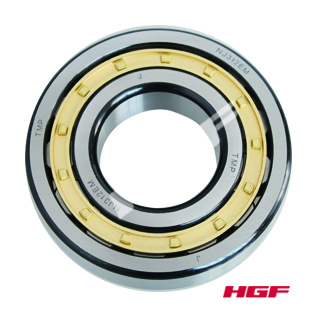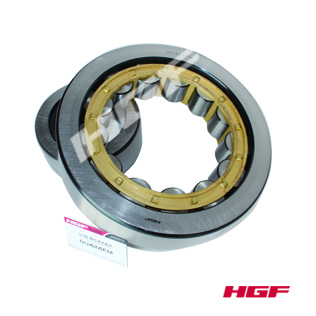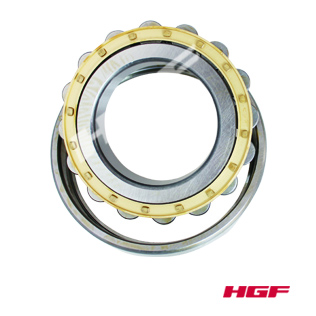Bearing fault detection, diagnosis, analytical skills
Bearing fault detection, diagnosis, analytical skills
For as long as possible in order to maintain a good state bearing the original performance, must be maintenance, testing, maintenance, in order to prevent accidents in the first place, to ensure reliability of operation, increase productivity, economy. Long-term operation of the equipment is concerned, the usual detection and tracking is particularly important test items including rotating sound, vibration, temperature, state of the bearing lubricant, etc., according to test results, equipment maintenance personnel can accurately determine the problem point device, make early prevention and solutions.
First, sound analysis and diagnosis of abnormal rotation
Abnormal rotation tone detection analysis is the use of auscultation bearing working condition monitoring analytical methods commonly used tool is a long wooden handle screwdriver, you can also use an outer diameter of about 20mm rigid plastic tube. In contrast, the use of electronic stethoscope to monitor more conducive to improving the monitoring of reliability. Bearing in normal working condition, smooth, light, no stagnation, harmonious sound without noise occurs, you can hear the uniform and continuous "buzzing" sound, or low "humming" sound.
Bearing failure abnormal sound reflected as follows:
1, bearing issued uniform and continuous "hissing" sound, the sound of the rolling bodies, including the outer ring rotates to produce, including irregular metal vibrating sound and speed-independent. The general performance of the bearing grease levels are low, it should be supplemented. If the equipment down time, especially at low temperatures in winter, bearing in operation sometimes issue a "rustling hissing" sound, which is bearing radial clearance becomes smaller, grease penetration of smaller work-related. Should be properly adjusted bearing clearance, replace the penetration bigger new grease.
2, bearing issued in a continuous "buzzing" sound even cyclical "Lo ho" sound, the sound is due to the rolling elements and raceways appear scars, grooves, rust spots caused. Speed is proportional to the sound of the cycle and the bearing. Coping bearing replacement.
3, bearing issue irregular, uneven "Cha Cha" sound, the sound is due to fall within the bearing iron, sand and other impurities caused. Sound intensity is small, and the number of revolutions of no contact. Coping bearing cleaning, re-greasing or oil changes.
4, bearing emits a continuous irregular "imperfections" sound, the sound is generally the inner ring and the shaft bearing outer ring fit is too loose or too loose with the bearing hole with a relationship. When the sound greater strength to deal with the relationship between the bearing inspection, identify problems and timely repairs.
Second, the vibration signal analysis and diagnosis
Bearing vibration of the bearing damage is very sensitive, such as peeling, indentation, corrosion, cracks, wear, etc. will be reflected in the bearing and vibration measurements. So, through the use of special bearing vibration measurement device (frequency analyzer, etc.) to measure the size of the vibration, the frequency distribution can be inferred by abnormal circumstances. The measured values due to the use of conditions or bearing sensor installation location, etc., and thus requires prior to each machine measurements were determined after analysis and comparison criteria.
Rolling bearing fault detection and diagnosis technology there are many, such as the vibration signal detection, lubricating fluid analysis testing, temperature testing, acoustic emission testing. In various diagnostic methods, diagnostic techniques based on the most widely used application of vibration signals, the technology is divided into two simple diagnostic method and precision diagnostics.
Simple diagnostics using the vibration signal waveforms of various parameters such as amplitude, form factor, crest factor, probability density, kurtosis coefficient, and various demodulation techniques bearings preliminary judgment to confirm whether there is a fault;
Precise diagnosis is the use of a variety of modern signal processing methods in simple diagnostic judgment is considered a fault category and the reasons for failure of the bearing.
Simple diagnostics three, bearing failure
In using the vibration of the rolling bearing simple diagnostic process, usually to the measured vibration value (peak, RMS, etc.) and the pre-given certain criteria to compare the measured value is given based on the vibration exceeds the standard limits to determine whether the bearing failure, to determine the need for further diagnostic precision. Simple diagnostic criteria for rolling bearings can be roughly divided into three types:
1, the absolute criteria
For determining whether the measured vibration value of the absolute magnitude of the overrun;
2, relative criteria
On the same site on a regular basis bearing vibration detection, according to chronological were compared to standard bearing vibration is no fault in the case, according to the measured vibration values Vibration value than the reference standard for diagnosis;
3. analogy criteria
Several of the same type under the same conditions as bearing vibration detection at the same site, and the vibration values compared with each other to judge the criteria.
Absolutely is standard on the basis of criteria specified in the developed detection method, we must pay attention to the applicable frequency range and must be vibration detection according to the method prescribed. For all bearing absolute criteria it does not exist, and therefore are generally use either absolute criteria, the relative criteria and analogies criteria, so as to obtain accurate and reliable diagnosis.
Fourth, precision rolling bearing fault diagnosis method
Rolling frequency component is very rich, containing both low-frequency component, also contains high frequency components, and each corresponds to a specific fault specific frequency components. Sophisticated diagnostic task, that is to the specific frequency component separated by appropriate signal processing method, thereby indicating the presence of a particular fault.
Commonly used diagnostic precision are the following categories:
1, the low-frequency signal analysis
The low-frequency signal is a frequency lower than the vibration of 8kHz. Usually measurements are made when the rolling bearing vibration acceleration sensors, but the low frequency vibration velocity signals are analyzed. Thus, after the acceleration signal to be converted by the integrator charge amplifier velocity signal, and then through the upper cut-off frequency of 8kHz low-pass filter to remove high frequency signal, frequency components finally analyzed, to find the characteristic frequency of the signal, be diagnosis.
2, the high frequency signal demodulation analysis
Frequency range IF signal is 8kHz-20kHz, the frequency range of the high-frequency signal is 20kHz-80kHz. Because of the high frequency signal can be directly analyzed acceleration sensor signal after a charge amplifier, directly through a high-pass filter to remove low frequency signal, and then demodulates, and finally performing frequency analysis to identify the characteristic frequency of the signal.
Fifth, the bearing temperature analysis and diagnosis
Bearing temperature, generally room temperature outside the bearing can be inferred, the hole can be measured directly if the use of the bearing outer ring temperature, is more appropriate.
Generally, the bearing with the bearing operating temperature slowly began to rise 1-2 hours to reach steady state. The normal temperature of the bearing due to heat capacity, heat capacity, speed and load of the machine and different. If the lubrication, improper installation, the bearing temperature will be rapid-rise, there will be abnormal high temperature, when to stop running, take the necessary precautions.
Often represented by high-temperature bearings in unusual circumstances. High temperature is also harmful to the bearing lubricant. Sometimes bearing overheating can be attributed to the bearing lubricant. If the bearing temperature over 125 ¡æ even move to reduce long-term bearing life. Causes high temperature bearings include: lack of lubrication or excessive lubrication, internal lubricant contains impurities, the load is too large, bearing damage, lack of space and high-friction seals and so on.
Thus, continuous monitoring of bearing temperature is necessary, whether it is measured bearing itself or other important parts. If you are under the same operating conditions, any change in temperature may indicate a fault has occurred.
Regular amount bearing temperature measured by means of a thermometer, such as SKF digital thermometer can accurately measure bearing temperature and fixed in accordance with ¡æ or Fahrenheit units.
The importance of bearing, which means when it is damaged, can cause equipment downtime, so the best type of bearing temperature detectors should be installed.
Under normal circumstances, the bearing lubrication or just after the re-lubrication will naturally rise in temperature and for one day or two days.
Sixth, lubricant analysis and diagnosis
Lubricant analysis method is the use Ferrography, iron spectral analysis technique is particularly suitable for a method of rolling contact fatigue in the identification and prediction. Rolling lubricating oil extraction as part of the oil sample, using a high gradient magnetic field flowing through the oil sample contained in the magnetic field of solid foreign objects, according to size ratio is deposited on the glass, able to observe the shape, size, color and texture of foreign particles , which can clearly ascertain the type of wear and tear, trailer machine operating state, to detect hidden dangers. Ferrography on principle to identify ferromagnetic steel as the main target, but the non-ferrous metals such as copper, sand, organic matter and seal debris and other foreign matter also has very good ability to identify.
When the diameter of 1-5¦Ìm steel spherical particles appear in the oil sample, the affirmative has started bearing fatigue microcracks. When the oil sample length to thickness ratio appears 10: 1 fatigue spalling particles, and a length greater than 10¦Ìm, the bearing of abnormal fatigue wear has begun, when the length is greater than 100¦Ìm, the bearing has failed.
The third fatigue debris length to thickness ratio of 30: 1 foil fatigue, its length between 20-50¦Ìm, often with empty sheet. When fatigue began to appear, the number of such sheets will be significantly increased, which together with spherical particles appear as a sign of fatigue.
VII, acoustic emission testing
Acoustic emission testing technical principles, materials produced by external or internal forces deform or crack, in the form of elastic waves released strain energy phenomenon called acoustic emission. Technical instruments to detect, analyze acoustic emission signals and signal estimation using acoustic emission acoustic emission source is called acoustic emission testing technology, which utilizes internal particulate matter due to the relative movement in the form of elastic wave phenomena strain energy release to identify and understand the material or structural internal state.
Acoustic emission signal includes a burst-type and continuous type two. Sudden acoustic emission signal by the distinguished background noise pulses, and can be separated in time; a single pulse of continuous acoustic emission signals indistinguishable. In fact, continuous acoustic emission signal is also by a large number of small burst-type signal component, but it is too dense and can not be resolved. Rolling In case of insufficient run, burst and continuous acoustic emission signals are likely to generate. Bearing the components (inner, outer ring, rolling elements and cage) relative movement between the contact surfaces, Hertz contact stress Rubbing generated, as well as due to the failure, overload generated such as surface cracks, wear, indentation, grooving, occlusal surface roughness caused by poor lubrication, surface of the hard edge lubrication caused by pollution particles and pitting and other current through the bearing failure caused, will produce unexpected type of acoustic emission signals.
Continuous acoustic emission signals mainly from poor lubrication (such as failure of the lubricant film, grease immersion pollutants) causes the bearing surface oxidation wear generated global failure, high temperature, and bearing partial failure-prone, etc. These factors contribute to a large number of short bursts of acoustic emission event, resulting in a continuous acoustic emission signals. Rolling bearing during operation, the fault (whether surface damage, cracks or wear failures) will cause the elastic impact arising from the contact surface acoustic emission signal which contains rich Rubbing information, so you can take advantage of acoustic emission monitoring and Roller Bearing Fault Diagnosis.
Eight, the vibration signal detection
Simple diagnostic rolling bearing fault detection method using a rolling bearing vibration signal analysis fault diagnosis can be divided into two simple diagnostic method and precision diagnostics. Simple diagnostic purpose is to determine a preliminary diagnosis of the object to be classified as rolling bearings if there is a fault; the purpose is to determine precise diagnosis in a simple diagnosis is considered a fault type and cause of the failure of the bearing.
The following summary describes several methods diagnosis:
1, amplitude value diagnostic method mentioned here refers to the peak amplitude value XP, mean X (for simple harmonic motion is the average half cycle, for bearing shock and vibration as the average absolute value after treatment), and the mean-square rms (RMS) Xrms. This is one of the easiest and most commonly used diagnostic method, which is obtained by the amplitude value criteria given in the measured values are compared to the diagnosis. It reflects the maximum peak amplitude at some time, so it is suitable for fault diagnosis like surface pitting damage and the like have an instantaneous impact. Effect Mean peak for the diagnosis of essentially the same, the advantage of representing the peak detected value is stable, but it is generally the case for high speed (e.g. 300r / min or more). Rms value is the average of the time, so it is suitable for fault diagnosis such as amplitude values of wear slowly changing with time.
2, the probability density diagnostics, trouble-free rolling bearing amplitude probability density curve is typical of a normal distribution curve; and once failure occurs, the probability density curve may appear skewed or dispersed phenomenon.
3, kurtosis coefficient diagnostics, amplitude satisfy normal distribution of fault-free bearings, the kurtosis value of approximately 3. With the emergence and development of failure, kurtosis and crest factor values have similar trends. The advantage of this method is independent of bearing speed, size and load, primarily for the diagnosis of pitting fault.
4, form factor diagnostics, form factor is defined as the ratio of the peak and the average of the (XP / X). This value is also one of the effective index for Rolling simple diagnosis.
5, crest factor diagnostics, crest factor is defined as the ratio of the peak and rms value (XP / Xrms). This value is used to the advantage of rolling bearings is that it is not simple diagnostic bearing affect the size, speed and load, but also from one instrument sensitivity change affect the secondary sensor amplifiers. The value for the diagnosis of pitting fault. Through the XP / Xrms value monitoring trends over time, it can effectively rolling bearing fault early warning, and to reflect changes in trends failure. When the rolling bearing no fault, XP / Xrms, as a small stable value; once in bearing damage, it will have an impact signal, vibration peak increased significantly, but at this time there is no significant increase in the rms value, Therefore XP / Xrms increases; when the fault continues to expand, and gradually peak limit is reached, the rms value then begins to increase, XP / Xrms gradually reduced until it is restored to a size no fault.
By applying the above key equipment bearing component detection means tracking and detection of its operating status can effectively diagnose equipment bearing parts of risks, early prevention to ensure the normal use of equipment.
- 2016.03.03Industry News£ºReducer bearing a..
- 2016.03.03Industry News£ºWithout knowing t..
- 2016.03.03Industry News£ºUltrasonic vibrat..
- 2016.02.17Industry News£ºHigh-speed railwa..
- 2016.01.30Industry News£ºLow vibration bea..












